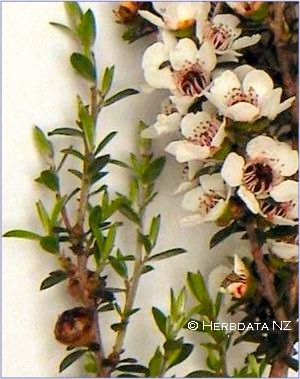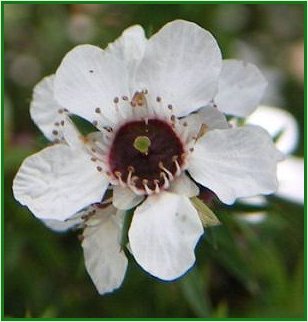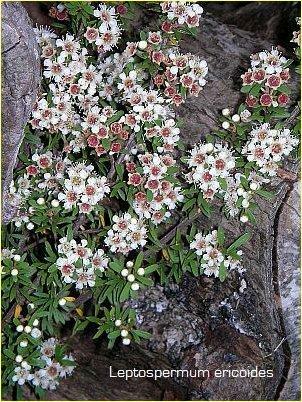
New Zealand
Tea Trees.
Leptospermum scoparium (Manuka)
Leptospermum ericoides (Kanuka)
Compiled and introduced by Ivor Hughes.
Plants of
New Zealand
� 5th Edition Revised,
by
R.M. Laing, B.Sc., F.R.S and E.W. Blackwell (Mrs. Thomas
Maidment)
New Zealand
is a blessed land and no more so than in its Native Sons and Daughters
both Maori and Pakeha. This little gem of a book is long since out of
print but it is a classic work both of scholarship and its love of subject
which shines forth in its treatment of the New Zealand Flora. A
labour of love. The authors introduce
their work with the following verse;
�Oh when I am safe in my sylvan home, I tread upon the pride of Greece
and Rome, and when I am stretched beneath the pines, Where evening star so
holy shines, I laugh at the lore and pride of man, At the sophist schools
and learned clan, For what are they in all their high conceit, When man in
the bush with God may meet�.
R. W. Emerson.
Calder, Cole and Walker1
state that both species of Tea Tree; the Red Tea Tree and
the White Manuka contain antibiotic substances effective against; E. coli. S. aureus. B. sub. C.
alb. E. floc.
These species of micro organisms are now resistant to most of our
synthetic armament but we may rest sure in the knowledge that Nature in
her fecundity caters for all our needs. Manuka
is the Maori name for the Red Tea Tree for which the image is shown of the
flowering tops. The ripe seed capsules were chewed by the Maori as an
astringent. The timber is much esteemed as firewood and burns with an
intense heat reminiscent of Hawthorn which was used in
Britain
to smelt iron. The volatile oil is obtained from the young tops by means
of steam distillation. The volatile oil and the honey from its flowers brings
a premium price and enjoys a global demand for its health giving
properties.
1. Victoria L.
Calder, A.
L. .J. Cole and J. R. L. Walker. Antibiotic
compounds from
New Zealand
plants. Journal of the
Royal Society of
New Zealand
Volume 16. Number 2.
1986. pp 170 � 171.
 �Plants of
New Zealand
� 5th Edition Revised,
�Plants of
New Zealand
� 5th Edition Revised,
Myrtaceae
THE
MYRTLE FAMILY.
Distribution
A large family of about 2800 species, chiefly
tropical Many of them abound in aromatic oils, while others furnish gums.
The flowers of this family are very similar to those of the Rosaceae. the
main distinction between them being that the carpels are more or less
free, particularly in the stigmatic region, in the Rosaceae; whilst in
Myrtaceae, the carpels are completely united, the union extending to the
stigmas. Many of the myrtles, also, have glands in all their parts, which
secrete ethereal oils that give the plants an aromatic odour. This is,
perhaps, the most striking character of the family. The corolla is usually
white, and the filaments, which are often a bright red, serve as the chief
organs of attraction for insects. Cloves are the flower buds of a species
of Eugenia. Another species of the same genus furnishes the fruit from
which allspice is obtained. The guava is the fruit of Psidium guava. The
only European species is the well known Myrtle.
The
oil of eucalyptus, obtained from Eucalyptus globulus, is antiseptic in its
action. This tree is often planted, on account of its rapid growth, for
the purpose of drying up swamps, and thus keeping off malarial fevers.
Genus Leptospermum.
Shrubs or trees, with
alternate entire leaves.
Flowers regular, white or pink. Calyx
5-lobed, petals 5; stamens numerous. Capsule
woody. About 28 species, of which 3 belong to
New
Zealand
,
and 20 to
Australia
.
Leptospermum scoparium
(The �Manuka).
A shrub or tree,
sometimes 30 ft. in height.
Leaves leathery, hard, with sharp points.
Flowers scentless, on very short stalks, white or rosy, � in.-
� in. across. Capsule
bursting by 4 or 5 valves, very woody. Maori names Manuka,
Kahikatoa. English name, Tea-Tree. Both islands.
Fl. Nov.-April.
This is the most abundant of
New
Zealand
shrubs. It is the colonial counterpart of the English broom and gorse, and
is as beautiful as either of these. One of the loveliest sights of the
land is a great valley at Christmas-time, clad with Leptospermum in full
flower. From the distance of a mile or two, the country seems to be spread
with a sheet of snow, so profusely does the plant flower. A variety now
named Nicholsii, with dark crimson blooms, was found at Chaney's Corner,
near Kaiapoi. It is a magnificent plant, and at the beginning of the Great
War (WW1) was selected by the Royal Horticultural Society of London as the
greatest novelty of the year. Plants were then sold at twenty-five pounds
apiece.
To the Maoris the tree was known as the manuka. By the bushmen
it is generally called tea-tree. It has acquired this name because early
voyagers and colonists sometimes used its pungent leaves in place of tea.
Indeed, the whole plant, including leaves, flowers, fruit, and young
shoots, is highly aromatic, and the oil which it contains, will perhaps,
in future, be put to some useful purpose.
The flowers are generally bisexual, but are sometimes imperfect or
unisexual. A branch may occasionally be found bearing flowers which are
staminate only, while on the lower portion of
the same branch last year's capsules are borne. The capsule is hard and
woody, of a reddish-brown colour. Very small specimens occasionally bear
flowers. A plant was once observed, not more than half-an-inch in height,
which bore a flower and duly developed seed. The flower appeared to be
actually lying upon the ground.
The wood of this tree is largely used for fences and firewood. The Maoris
made use of it for their paddles and spears, and a bunch of the twigs
makes an excellent broom. The manuka is a most plastic plant, and can
adapt itself to wide changes of environment. It may be found on mountain
tops in excessive wind, dwarfed almost to a cushion plant. It grows also
on the seashore, in swamps, on dry land, and on rocky cliffs. Few plants
have such a wide range of habitat. It may be only a few inches high, or a
tree of 25 ft. or more. It very often replaces the bracken fern, some
years after a fire. It is most abundant throughout the Dominion. As a
result of injuries caused by sap-sucking insects the leaves are sometimes
covered with a white crystalline substance, known as manuka manna. The
substance is probably a complex sugar, but so far has not been thoroughly
investigated.
 Leptospermum ericoides (The
Tree Manuka).
Leptospermum ericoides (The
Tree Manuka).
A larger tree than the
preceding.
Leaves narrow, acute, glabrous or silky, fascicled.
Flowers in. across, white, very fragrant.
Maori name Manuka-rauriki, but now very often called the Kanuka. Both
islands. Fl. Nov.-
Jan.
This is nearly, but not quite, as common a plant as the previous one. Like
the former species, at high levels, in wind-swept localities, it becomes
prostrate, and is reduced to a few inches in height. In suitable
positions, however, it grows to be a larger tree than L. scoparium,
sometimes attaining a height of sixty feet, and a diameter of one to three
feet. Its timber is hard and durable, and is used for jetty piles, spokes
of wheels, fence-rails, and other purposes. It is also much sought after
for firewood, and this has led to the cutting out of all the larger trees
over wide areas, so that in many places it is now impossible to procure
it. To many old settlers, however, the odour of
burning Kanuka logs brings memories of the pleasant winter evenings of
times long past.
Older trees of both species have their trunks covered with a light
brown bark, that readily strips off,
and is frequently used for fire-kindling. For the camper-out,
Leptospermum provides fragrant bedding, easily collected, and not
readily surpassed for comfort. There is little undergrowth in the
manuka copse, and the ground below it becomes carpeted with dead
leaves, almost as in a pine forest. There are, perhaps, several
reasons for this lack of undergrowth. The plant often grows on
poor ground; the resinous leaves may, like the pine needles, make
bad mould; and the shrub itself probably exhausts the soil. Yet
sometimes certain orchids are found below it, which are rare
elsewhere, and various other plants seem to prefer the manuka
grove as a habitat.
Mr. G. M. Thomson has discussed the probable origin of the
New
Zealand
species. L. scoparium, with sharp leaf tips, is said to be found
abundantly in south-eastern
Australia
*;
but L. ericoides, with less pungent points to its leaves, is
endemic. Mr. G. M. Thomson states that the rigid sharp-pointed
leaves of the former indicate that the species originated in a
land where there were herbivorous Mammalia, for he considers that
"such sharp-pointed leaves are probably so developed in order
that they may be as obnoxious as possible to grazing
animals."!
As the genus has come to us from a northern land, where possibly
marsupials and other grass-eating animals were abundant, this
explanation seems feasible. It also appears to receive
confirmation from the fact that the endemic species has less
prickly leaf-tips than the one with wider distribution. However,
there is another, and, perhaps, simpler interpretation of such
sharp-pointed leaves. They may be due merely to leaf-reduction,
produced as a means of protection against excessive
transpiration
(v. Aciphylla, Hebe,
Discaria).
Indeed, that the modification, in the case of Leptospermum scoparium, is
climatic rather than defensive, is shown by the
fact, that, in certain mountain localities, the leaves become less rigid,
more rounded, and less acute. .
* There
is some doubt as to the identity of the local and Australian species, �
New Zealand Journal of Science, Vol. II., p.
See
also Ti Trees of the Oceania region
Did
you find what you were seeking? if not please use the site search at the
top right hand of the page, or else return to the site library for further
information


 �Plants of
�Plants of  Leptospermum ericoides (The
Tree Manuka).
Leptospermum ericoides (The
Tree Manuka).![]()